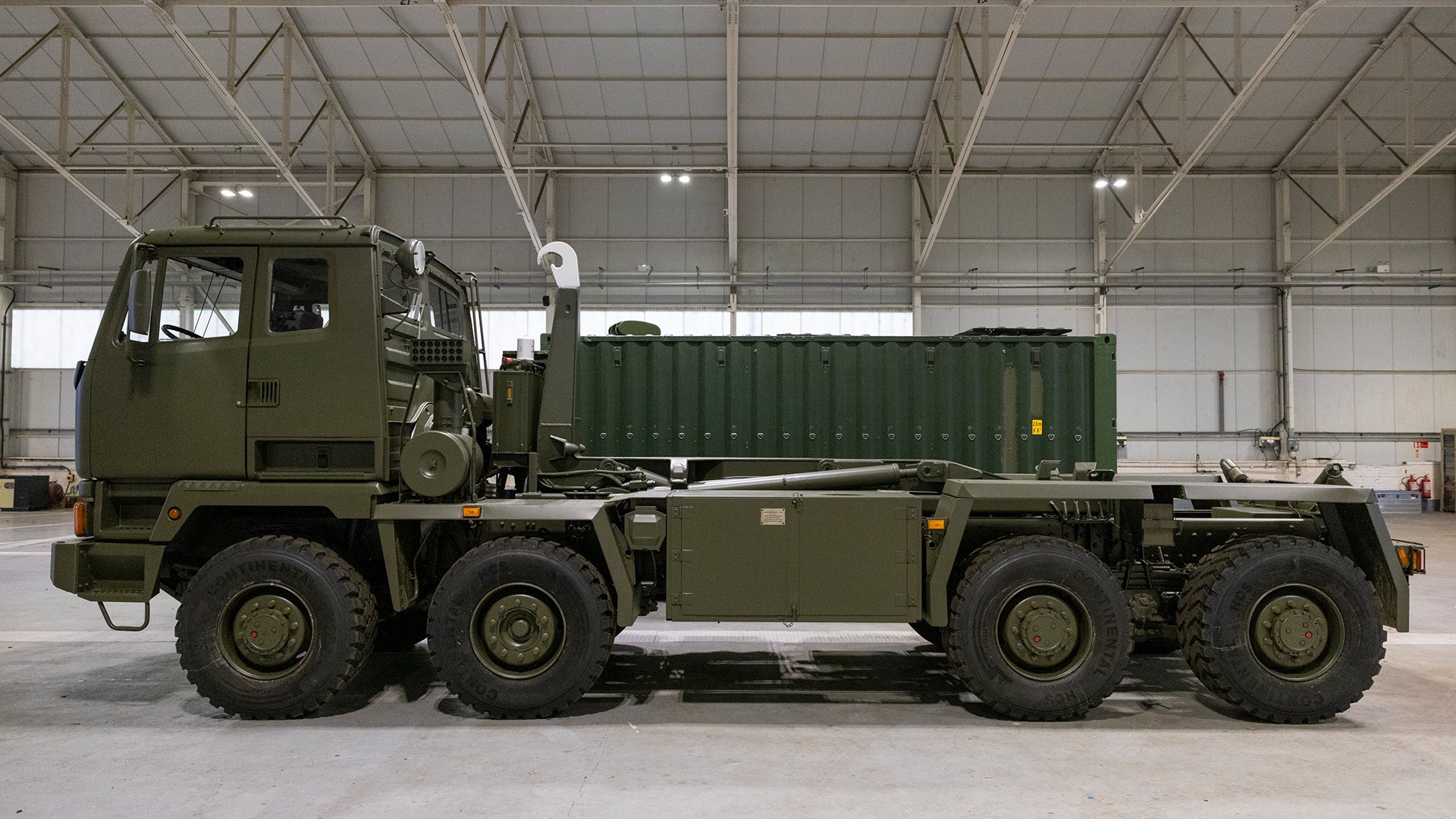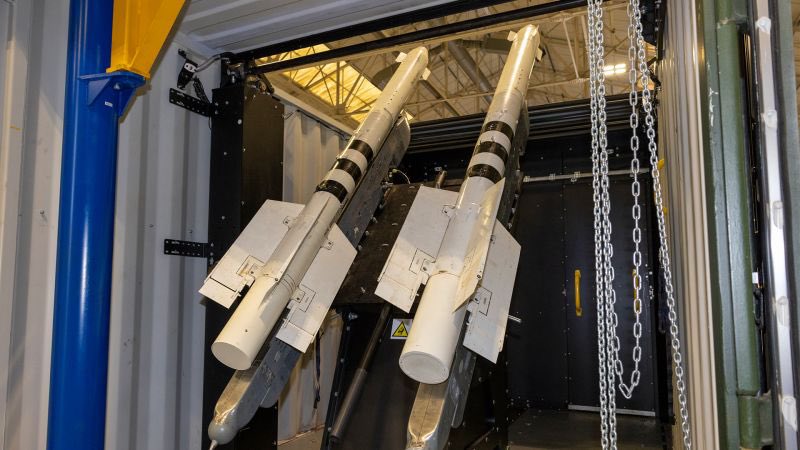Ukraine has reportedly acquired a new weapon system to defend against the barrage of missiles unleashed by Russia: the Gravehawk hybrid surface-to-air missile system.
The photos and videos of the Gravehawk were published by the UK-based publication Forces News on February 12.
The system’s visuals, developed by the United Kingdom in collaboration with Denmark, have since been posted to social media and gone viral. During a recent visit to NATO headquarters in Brussels, British Defense Minister John Healey said the system demonstrates the UK’s long-term support for Ukraine in its conflict with Russia.
The Gravehawk system was announced on January 16 during UK Prime Minister Keir Starmer’s visit to the war-torn nation. It has been described as a UK-designed “mobile air defense system,” the size of a shipping container, that can “retrofit” air-to-air missiles into a ground-based air defense role.
The Ukrainian Armed Forces can now use missiles already in stock without letting ammunition delivery delays affect their operational capability.
“With Ukraine under constant Russian bombardment, the Gravehawk system will boost Ukraine’s air defenses, allowing them to defend their cities, troops, and critical infrastructure,” the UK Government said earlier. The development is ostensibly a part of a larger £4.5 billion (US$5.5 billion) boost for Ukraine in 2025, which will see the UK acquire “hundreds more air defense systems, drones, and essential equipment support to sustain Ukrainian forces on the front line.”
The Gravehawk uses the infrared-guided R-73 (AA-11 Archer) short-range air-to-air missile, which has been modified for launch by a ground-based system.
According to new details disclosed by Force News, the Gravehawk system’s objective is to defend against airplanes, cruise missiles, and drones. The system’s ground-up development took about 18 months. A small team of the UK Ministry of Defense, Taskforce Kindred, which supplies Ukraine with British weaponry and equipment, implemented the project.
This is not the first time that a system like Gravehawk has been developed for Ukraine. In fact, it is similar to the FrankenSAM air defense systems that the United States developed in collaboration with other NATO countries and delivered to Ukraine. The Anglo-Danish Gravehawk has been built for the same reason as FrankenSAM: the lack of easily accessible air defense systems for Kyiv.

The US has helped Ukraine with multiple FrankenSAM hybrid air defense projects, including US Sea Sparrow missiles integrated into Soviet-era Buk launchers and the US Sidewinder air-to-air missile coupled with a Soviet radar. There have been reports that Patriot missiles have also been used in a hybrid AD system, but the EurAsian Times could not independently verify that information.
Additionally, the UK has also previously developed a FrankenSAM-like system that reportedly uses AIM-132 Advanced Short-Range Air-to-Air Missile, or ASRAAM, mounted on a 6×6 Supacat High Mobility Transporter (HMT).
The development of these systems has been prompted by relentless Russian aerial strikes on Ukrainian cities, especially by loitering munitions and kamikaze drones.
Russia has launched a massive campaign of airstrikes using drones on Ukraine’s vital national infrastructure since the middle of 2024 and throughout the winter, leaving Ukraine’s air defense system overstretched. Moreover, Ukrainian President Volodymyr Zelenskyy has stated on multiple occasions in recent times that the country needs more sophisticated air defense launchers and missiles to mount a strong defense against Russia.
However, there is an abysmal mismatch in the demand and supply of interceptors coming from NATO allies. Thus, a hybrid system that utilizes abundant missiles in the Ukrainian inventory to take down Russian aerial targets is significant.
Having said that, the timing of the Gravehawk is significant, with US President Donald Trump looking to end the war. Trump said on February 12 that he and Vladimir Putin had a “lengthy and highly productive” phone conversation during which the two leaders decided to start talks to end the Ukraine conflict.
With the future of this grinding war uncertain, both sides are expected to intensify their attacks before negotiations start.
What Do We Know About Gravehawk?
Gravehawk is a British-built surface-to-air missile system that uses RM-73 air-to-air missiles and can be operated by a five-person crew.
“The system is housed inside an ordinary ISO shipping container, meaning it can be quickly deployed on the back of a lorry, known as a Drops vehicle. Once on the ground, the roof of the container can be rolled back to reveal the missile system inside, which is made up of two weapons rails taken from Soviet-era fighter jets such as the Sukhoi Su-27 Flanker,” states the report.
The R-73, originally designed for close-in aerial dogfights and used by MiG-29 and Su-27 aircraft, boasts advanced control surfaces and thrust vectoring, making it highly maneuverable and deadly in close combat scenarios. Depending on the type, the R-73 missile can hit targets up to 300 meters in the rear hemisphere and 20 (RMD-1) to 40 (RMD-2) kilometers away in the front hemisphere. Many of these missiles are used by the Ukrainian Air Force and can be purchased on the global arms market.
The R-73 is capable of high-off-boresight (HOBS), which means that the seeker can identify targets up to 40° off the missile’s centerline and modify its flight in any direction, compared to traditional heat-seeking air-to-air missiles with seekers that have restricted forward view.

Interestingly, the R-73 has been successfully used for another hybrid solution in the Ukrainian Armed Forces. Last year, for instance, Ukraine armed its explosive drone boats and Unmanned Surface Vessels (USVs) with these missiles to hunt down Russian helicopters and fighter jets.
The report states, “On top of the container is a camera system that uses passive IR to locate a target. An image from the camera is sent to a command module about the size of a large Peli case, which shows the target and then locks on before the missiles are fired. All the system needs to track a target is a heat signature.”
Unlike surface-to-air missile systems that depend on active radars, the Gravehawk’s passive infrared sensors keep it safe from Russian electronic warfare systems.
According to the MOD, the Ukrainian military has successfully tested two prototypes of these systems so far. This fiscal year, an additional fifteen are scheduled to be delivered to Kyiv. Denmark pays half of the approximately £1 million (US$1.25 million) cost of each Gravehawk system.
- Contact the author at sakshi.tiwari9555(at)gmail.com
- Follow EurAsian Times on Google News




